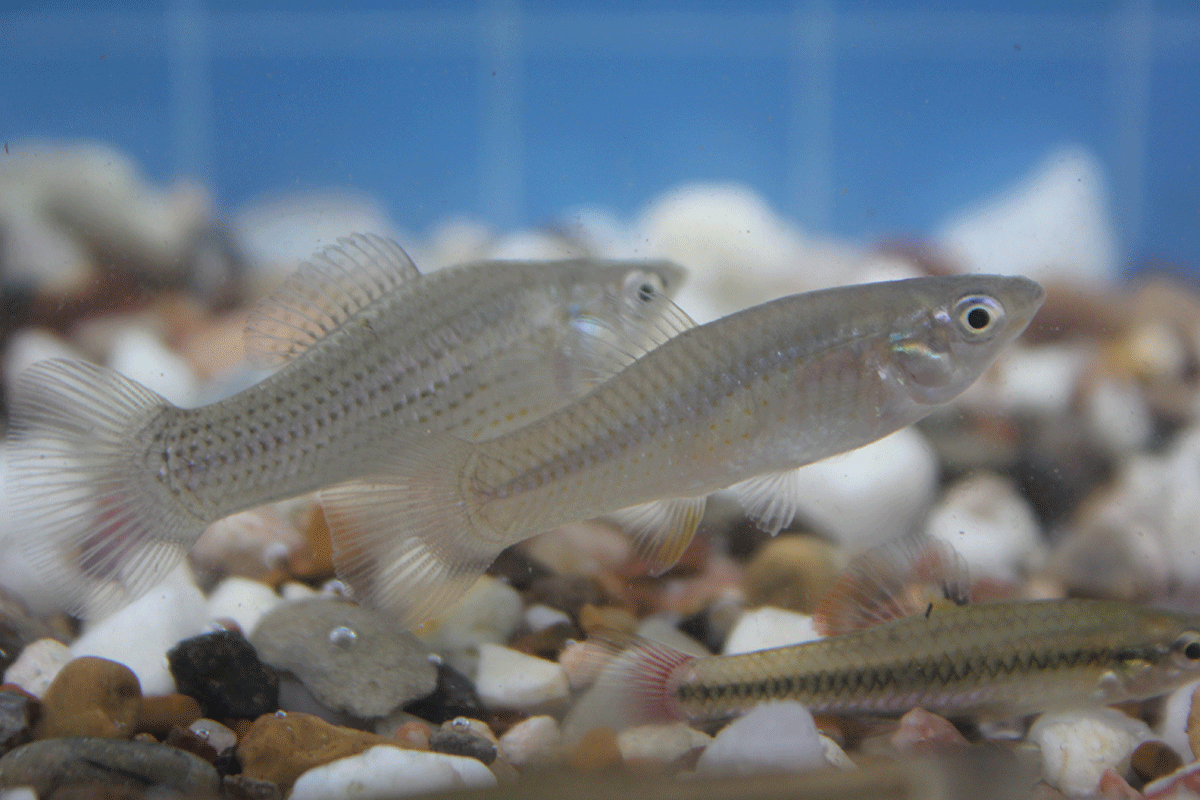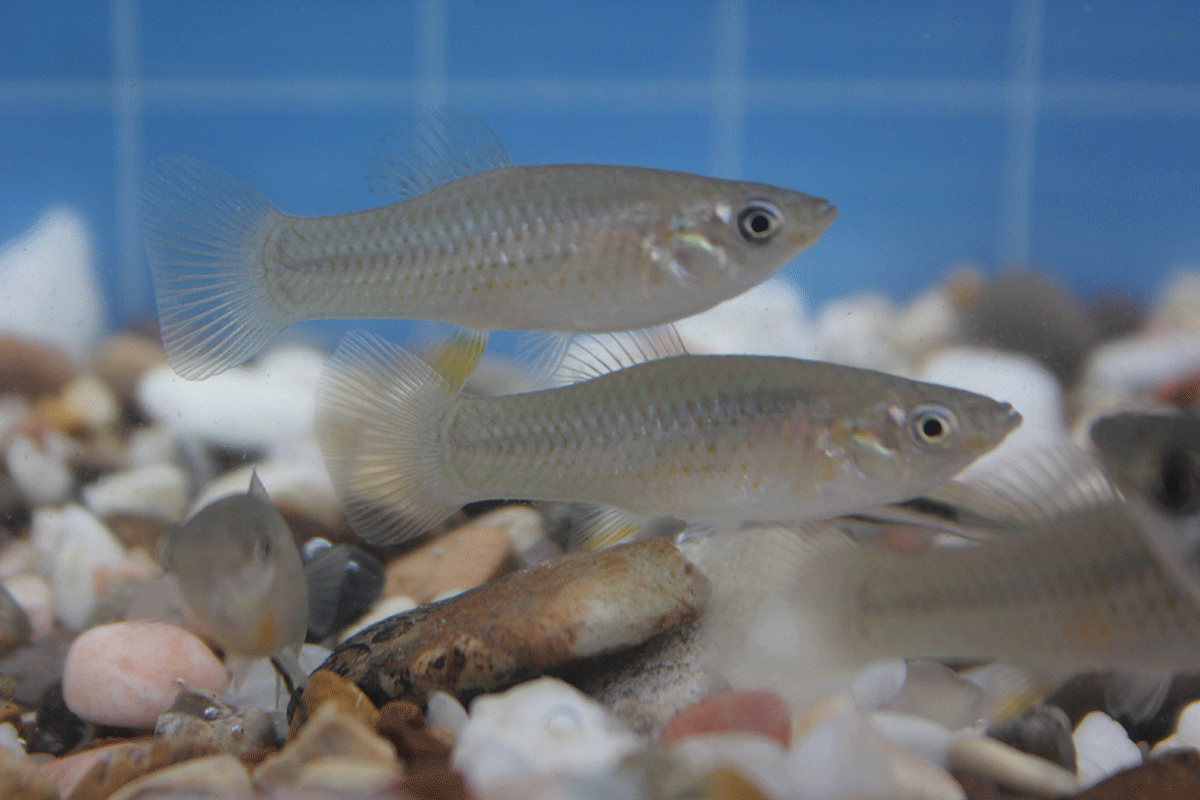Photo: Two Poecilia formosa, Amazon mollies, collected from Coleto Creek at Highway US 77 in Victoria County, Texas.
December 12, 2017, four of us plus two German Shepherds went collecting on Coleto Creek in Victoria County, Texas (see my blogs: http://goliadfarms.com/coleto-creek-collecting-trip-december-21-2017/ and http://goliadfarms.com/lucania-goodei-the-blue-fin-killifish/). During that trip, we collected a unique molly, Poecilia formosa, the Amazon Molly.
Poecilia is the genus containing mollies and guppies. The species name, formosa, according to http://atshq.org/articles/beechwp2.html, is Latin for “beautiful, finely formed.” I take some exception to the species name. I don’t find this fish to be particularly attractive. The common name, Amazon Molly, is more apt. It doesn’t, as you might imagine, denote the species’ natural range. Instead, it refers to the Amazons of Greek mythology, a tribe of women warriors. These fish aren’t warlike, but all the members of the species are female. I suppose since all the Amazon warriors were women, the name “Amazon” might apply to an all-female species.
Poecilia formosa is a unisexual species of molly that DNA analysis indicates arose as a hybrid a male P. latipinna and a female P. mexicana (Avise et al. 1991). All members of the species are female and are gynogenetic parthenogens. What does that mean? Well, it means the females produce clones of themselves, but require mating with a male to trigger egg development although the sperm contributes no DNA. For a very nice and readable description of this, go to http://rstb.royalsocietypublishing.org/content/363/1505/2901. Here’s a short excerpt from that site:
“In gynogenesis or sperm-dependent parthenogenesis, females produce unreduced oocytes that develop into all female offspring. They need, however, sperm from a closely related sexual species to trigger the onset of embryonic development. The male genetic material does not contribute to the offspring’ genotypes. Reproduction in gynogenesis is truly clonal.”
So, at some time in the past a male Poecilia latipinna mated with a female P. mexicana to produce a P. formosa. This apparently happened in northern Mexico (Rezneat & Abramoff 1968). For a map of the possible original range of this species, go to: http://maps.iucnredlist.org/map.html?id=191747. The portion of the range above the Rio Grande drainage is subject to question. The United States Geological Survey says:
“Native Range: Rio Grande drainage, extreme southern Texas; also in Mexico south to Veracruz.”
The map below shows USGS’s Texas range for the Amazon molly. The darker areas, which include Coleto Creek, are apparently introductions. The orange blotch on the Rio Grande represents the species’ only natural Texas range.

My experience with Poecilia formosa dates back several decades, but my recent experiences started in 2008 when the American Livebearer Association had its annual convention in San Antonio, Texas. One of the associated activities was a visit to San Marcos to visit the Xiphophorus Genetic Stock center at Texas State University (see: http://www.xiphophorus.txstate.edu/) and to collect fish in the San Marcos River. We collected a number of P. formosa, which none of the attendees had seen before. I still remember, almost a decade later, Ted Coletti, knee deep in the mud of a cut off pool, excitedly asking, “Charles, what is this fish?” I was across the pool, thirty feet away, dry and clean, but I knew without looking what the fish was. I asked, “Does it have an opalescent side?” Ted said, “Yes.” With a smile, I said, “Poecilia formosa.” I had expected they’d seine some up in the pool since I’d done so many times.
Although I’d seen P. formosa in San Marcos, which is a tributary of the Guadalupe River, I’d never in decades of collecting seen them in Coleto Creek. This creek is another Guadalupe River tributary about a hundred miles downstream of the San Marcos River. So, I was very surprised to net up a half dozen Amazon mollies among a hundred or so Poecilia latipinna, our native sailfin molly. The ones we netted juveniles and young adults and just starting to show the opalescent sides I’ve noticed in mature fish.
I’ve decided, after many, many mating trials, you don’t produce Amazon mollies by crossing Poecilia latipinna and P. mexicana. The event that led to Amazon mollies must have been a unique event. When I cross these two species, I get both males and females. The hybrid females mated either to hybrids or males of either parental species always produce male and females. The first generation (F1) hybrids are large fish with coloration intermediate to the two parents. The male dorsals are always small and resemble those of the short fin mollies not sailfins. F2 and beyond generations and back crosses produce a variety of colors and fin types. Someday, I’ll select from the descendants of this cross for sailfins and P. mexicana coloration, bluish body and orange and black caudal. In my attempts to produce a blue sailfin, I’ve done some selection, but with disappointing results.
Recent research shows Amazon mollies to be a lot more complicated than originally thought. There are triploid and tetraploid Poecilia formosa. Also, there are regional genetic variations as well as evidence that some male DNA has made its way into Amazon molly genome subsequent to the original cross that created it. If you are interested in these complications, you’ll want to read some of these documents:
http://www.pnas.org/content/110/34/13797.full.pdf?related-urls=yes&legid=pnas;110/34/13797
http://genome.wustl.edu/genomes/detail/poecilia-formosa/
https://academic.oup.com/jhered/article/99/2/223/2187701
http://rstb.royalsocietypublishing.org/content/363/1505/2901
Now that I have Poecilia formosa, I’ll grow them up and set them up for mating with some male P. latipinna to raise the next generation of Amazon mollies. To see the side-by-side differences between the females of these two species, look at the picture below. The upper, left fish is a young female P. latipinna collected along with a young P. formosa, which is the bottom, right fish.

Note the distinctive striping of the Poecilia latipinna female as contrasted to the flank of the P. formosa. As the later fish matures, the slight opalescence on her belly will expand.
Good fishkeeping!
References:
Avise J.C, Trexler J.C, Travis J, Nelson W.S 1991 Poecilia mexicana is the recent female parent of the unisexual fish P. formosa. Evolution. 46, 1530–1533. doi:10.2307/2409901.
Rezneat M.D, Abramoff P 1968 Distribution of the gynogentic fish, Poecilia formasa, with remarks on the evolution of the species. Copeia. 1968, 354–361. doi:10.2307/1441764.


Sonny H says
Excellent article Charles. The side by side comparison oh females, Latipinna and Formosa makes the distinction clear. Thanks.
charles says
Sonny,
Thank you.
What’s interesting is, according to research done by Dr. Caitlin Gabor at Texas State University, male Poecilia latipinna from populations that have never been exposed to P. formosa (she calls these “virgin populations”) prefer P. formosa females over P. latipinna females. But, males from “non-virgin” populations don’t have this preference. Generally, evolutionary biologists have felt males make such a small metabolic investment in mating that they are promiscuous and mate with most any receptive female. But, having watching male sailfin mollies courting females, I think the real investment a male makes is the risk he takes pursuing a female. His mating display is advertising to predators and makes his especially vulnerable. When I collect mollies in the wild there are always many fewer adult males than adult females. But, if I breed these fish in captivity, the male/female adult ratio is 1/1. Males in nature must experience much higher rates of predation than females d. So, it makes sense to me there would be selection for males that don’t like P. formosa females since they leave no offspring when mating with them.
Charles
Mary says
You’ve bred these before? Do you ever sell them? Fascinating reproduction process, thanks for sharing
Charles Clapsaddle says
Mary,
I’m sorry for the tardy response. I just saw this message.
Yes, I have bred them. We lost our population during the Texas Winter Storm but hope to collect some again soon.
Charles